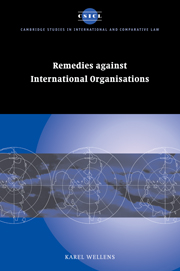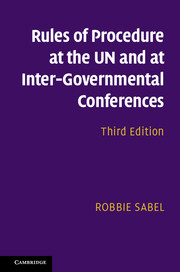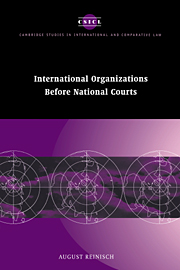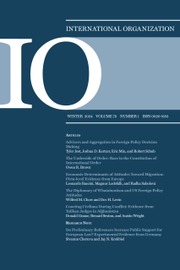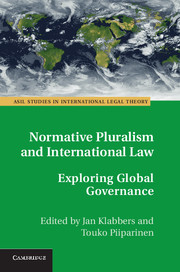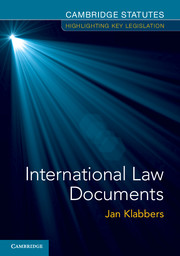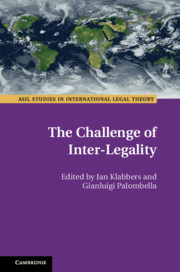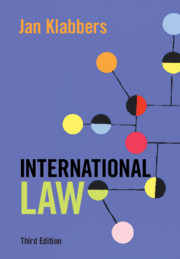An Introduction to International Organizations Law
4th Edition
- Author: Jan Klabbers, University of Helsinki
- Date Published: March 2022
- availability: This ISBN is for an eBook version which is distributed on our behalf by a third party.
- format: Adobe eBook Reader
- isbn: 9781108901970
Find out more about Cambridge eBooks
Adobe eBook Reader
Other available formats:
Paperback, Hardback
Looking for an inspection copy?
This title is not currently available on inspection
-
The fourth edition of this market-leading textbook offers students a clear framework for understanding the practice and logic of International Organizations Law. It is structured around the three defining relationships IOs engage in – namely, with their member states, with their organs and staff, and with the outside world. These different dynamics give rise to different concerns, which each help to explain the logic behind international institutional law. The text also discusses the essential topics of the law of IOs, including powers and finances, privileges and immunities, institutional structures, and accountability. By demonstrating how the theory works in practice, with recent examples, students will observe the impact and significance of International Organizations Law. Updated with the latest case law and literature, this new edition also contains discussions of the withdrawal of Israel and the US from UNESCO, Brexit, and the Covid-19 pandemic, and how these affect the law of international organizations.
Read more- Engages students by demonstrating how theories relate to real applications, including recent considerations like the withdrawal of Israel and the US from UNESCO, Brexit and the Covid-19 pandemic
- Structured in an understandable framework that aims to show how different aspects of the law are connected
- Treats international organizations as part of a larger landscape, not just as creatures of law, placing the work of international organizations in their social, political, and economic context
Reviews & endorsements
'Among the available textbooks on international organizations law, this book continues to stand out as the most conceptual one. Legal questions on the functioning of international organizations are answered in the context of a comparison of institutional rules. This approach is crucial to a better understanding of the nature of international organizations and their increasing importance in global rule-making.' Professor Ramses A. Wessel, University of Groningen
See more reviews'There is no better interpreter of the legal world of international organizations than Jan Klabbers. This new edition brings his classic text up to the minute while maintaining its sweeping overview of IOs in global history. It shows how Brexit, Covid, and other recent developments are entangled with the timeless questions about the authority, practice, and limits of international institutions. He navigates neatly among the nuance of legal theory, the apparent solidity of black-letter law, and the fluidity of practice. Even the footnotes are interesting. This is an essential book for scholars and students of international law and politics.' Professor Ian Hurd, Northwestern University
'A very welcome update of a classic textbook. Students of the law of international organizations will find a clear exposition and analysis of all key areas. Moreover, the tension between organizational autonomy and state sovereignty provides a powerful narrative which, when combined with the author's engaging style, makes the book much more than a teaching text.' Professor Nigel D. White, University of Nottingham
'The book brings together a wealth of illuminating illustrations drawn directly from the real world. The selection of these case studies is motivated not just by how helpful they are in clarifying the rules, but also by how well they show the rules' societal significance, and by their “entertainment” value – i.e. their potential first to captivate and then to keep the reader's interest in the materials.' Dr Otto Spijkers, Utrecht University School of Law
Customer reviews
Not yet reviewed
Be the first to review
Review was not posted due to profanity
×Product details
- Edition: 4th Edition
- Date Published: March 2022
- format: Adobe eBook Reader
- isbn: 9781108901970
- availability: This ISBN is for an eBook version which is distributed on our behalf by a third party.
Table of Contents
Preface to the fourth edition
Table of cases
A note on documentation
List of abbreviations
1. Introduction
2. The rise of international organizations
Part I. Member States and International Organizations
3. The legal position of international organizations
4. International organizations and the law of treaties
5. Issues of membership
6. Financing
7. Privileges and immunities
8. Legal instruments
9. Dissolution and succession
Part II. Internal Relations
10. Institutional structures
11. The bureaucracy
Part III. External Relations
12. Treaty-making by international organizations
13. Organizational liaisons
14. Issues of responsibility
15 Concluding remarks
Bibliography
Index.
Sorry, this resource is locked
Please register or sign in to request access. If you are having problems accessing these resources please email [email protected]
Register Sign in» Proceed
You are now leaving the Cambridge University Press website. Your eBook purchase and download will be completed by our partner www.ebooks.com. Please see the permission section of the www.ebooks.com catalogue page for details of the print & copy limits on our eBooks.
Continue ×Are you sure you want to delete your account?
This cannot be undone.
Thank you for your feedback which will help us improve our service.
If you requested a response, we will make sure to get back to you shortly.
×

